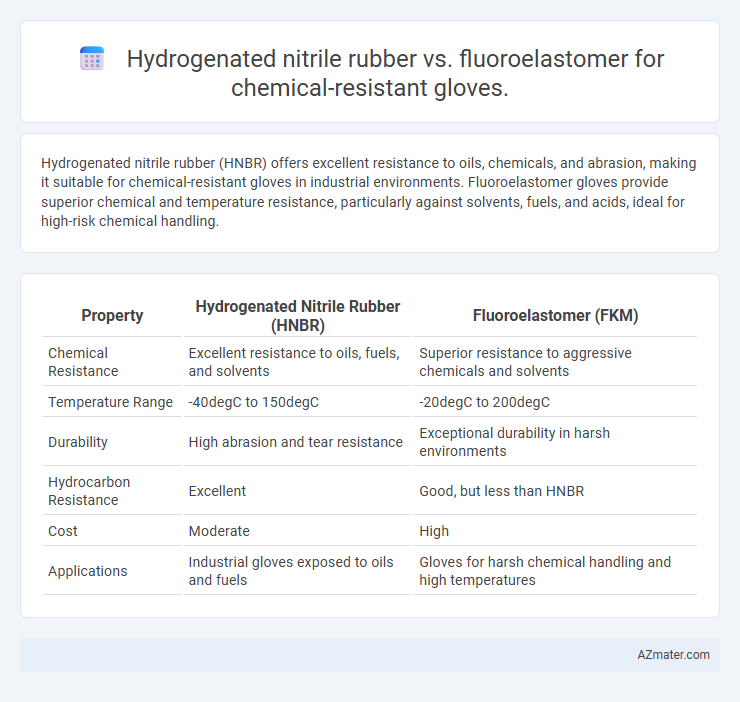Hydrogenated nitrile rubber (HNBR) offers excellent resistance to oils, chemicals, and abrasion, making it suitable for chemical-resistant gloves in industrial environments. Fluoroelastomer gloves provide superior chemical and temperature resistance, particularly against solvents, fuels, and acids, ideal for high-risk chemical handling.
Table of Comparison
| Property | Hydrogenated Nitrile Rubber (HNBR) | Fluoroelastomer (FKM) |
|---|---|---|
| Chemical Resistance | Excellent resistance to oils, fuels, and solvents | Superior resistance to aggressive chemicals and solvents |
| Temperature Range | -40degC to 150degC | -20degC to 200degC |
| Durability | High abrasion and tear resistance | Exceptional durability in harsh environments |
| Hydrocarbon Resistance | Excellent | Good, but less than HNBR |
| Cost | Moderate | High |
| Applications | Industrial gloves exposed to oils and fuels | Gloves for harsh chemical handling and high temperatures |
Introduction to Chemical-resistant Glove Materials
Hydrogenated nitrile rubber (HNBR) and fluoroelastomer are key materials used in chemical-resistant gloves, offering distinct advantages in harsh environments. HNBR exhibits superior resistance to oils, fuels, and aliphatic hydrocarbons, making it suitable for mechanically demanding applications with prolonged chemical exposure. Fluoroelastomer excels in protecting against a wider range of aggressive chemicals, including aromatic hydrocarbons, ketones, and acids, providing enhanced thermal stability and durability for high-risk industrial tasks.
Overview of Hydrogenated Nitrile Rubber (HNBR)
Hydrogenated Nitrile Rubber (HNBR) is a high-performance synthetic elastomer known for its exceptional chemical resistance, particularly against hydrocarbons, oils, and acids, making it ideal for chemical-resistant gloves in industrial applications. Its enhanced hydrogenation process improves thermal stability, ozone resistance, and mechanical strength compared to standard nitrile rubber, extending glove durability under harsh conditions. HNBR gloves offer superior protection in environments with exposure to petroleum-based chemicals, solvents, and aggressive cleaning agents, outperforming many traditional elastomers in lifespan and performance.
Overview of Fluoroelastomer (FKM)
Fluoroelastomer (FKM) offers superior chemical resistance, especially against fuels, oils, and aggressive solvents, outperforming hydrogenated nitrile rubber in high-temperature environments up to 200degC. Its molecular structure provides exceptional barrier properties and resistance to swelling, making it ideal for protective gloves in harsh chemical handling applications. FKM gloves combine durability with flexibility, ensuring long service life and enhanced safety for industrial workers exposed to aggressive chemicals.
Chemical Resistance Comparison: HNBR vs FKM
Hydrogenated nitrile rubber (HNBR) exhibits excellent resistance to aliphatic hydrocarbons, oils, and greases, making it ideal for gloves exposed to fuels and lubricants. Fluoroelastomer (FKM) outperforms HNBR in resistance to aromatic hydrocarbons, aggressive chemicals, acids, and high temperatures, providing superior durability in harsh chemical environments. In terms of chemical resistance, FKM covers a broader spectrum, especially against solvents and strong acids, whereas HNBR is preferred for moderate chemical exposure with enhanced mechanical strength.
Mechanical Properties and Durability
Hydrogenated nitrile rubber (HNBR) exhibits superior tensile strength and abrasion resistance, providing enhanced mechanical durability for chemical-resistant gloves, especially in environments involving oils and hydrocarbons. Fluoroelastomer (FKM) excels in high-temperature resistance and chemical inertness, maintaining integrity against aggressive solvents and acids, but generally offers lower elasticity and tear resistance compared to HNBR. Choosing between HNBR and FKM hinges on the specific mechanical demands and chemical exposure, with HNBR favored for rugged mechanical durability and FKM preferred for extreme chemical resilience and thermal stability.
Temperature and Environmental Stability
Hydrogenated nitrile rubber (HNBR) offers excellent temperature resistance up to 150degC and superior abrasion resistance, making it suitable for prolonged use in moderately harsh environments. Fluoroelastomer (FKM) excels with exceptional chemical resistance and can withstand continuous exposure to temperatures up to 200degC, providing enhanced environmental stability against oils, fuels, and solvents. Both materials deliver robust performance for chemical-resistant gloves, but FKM is preferred for extreme temperature conditions and aggressive chemical environments.
Cost Efficiency and Economic Considerations
Hydrogenated nitrile rubber (HNBR) gloves offer superior cost efficiency due to lower material and manufacturing costs compared to fluoroelastomer (FKM) gloves, making them an economical choice for applications requiring moderate chemical resistance. While FKM gloves provide exceptional resistance to a wider range of aggressive chemicals and higher temperatures, their significantly higher price point often limits their use to specialized industrial environments where extreme durability is critical. Choosing HNBR gloves balances adequate chemical protection with budget constraints, optimizing overall expenditure in industries like automotive and general chemical handling where cost control is crucial.
Common Industrial Applications
Hydrogenated nitrile rubber (HNBR) gloves offer excellent resistance to oils, fuels, and aliphatic hydrocarbons, making them ideal for automotive manufacturing, oil and gas industries, and heavy machinery maintenance. Fluoroelastomer (FKM) gloves provide superior chemical resistance against acids, solvents, and high temperatures, commonly used in chemical processing, pharmaceutical manufacturing, and aerospace applications. Both materials ensure enhanced durability and protection, but HNBR suits hydrocarbon environments while FKM excels in aggressive chemical and high-heat conditions.
Safety and Regulatory Compliance
Hydrogenated nitrile rubber (HNBR) gloves offer excellent resistance to a wide range of chemicals, including oils, fuels, and certain solvents, making them compliant with safety standards like ASTM F739 for permeation resistance. Fluoroelastomer (FKM) gloves provide superior protection against aggressive chemicals, such as acids, ketones, and hydrocarbons, and meet stringent regulatory requirements including FDA 21 CFR for food handling and EN 374 for chemical protection. Both materials comply with OSHA safety regulations, but FKM often surpasses HNBR in chemical resistance and longevity under harsh conditions, ensuring enhanced worker safety and regulatory adherence in demanding environments.
Which Material to Choose: HNBR or FKM?
Hydrogenated nitrile rubber (HNBR) offers superior resistance to oils, fuels, and aliphatic hydrocarbons, making it ideal for chemical-resistant gloves exposed to petroleum-based substances. Fluoroelastomer (FKM), known for its exceptional resistance to high temperatures, aggressive chemicals, and solvents, is the preferred choice for gloves used in harsh chemical environments involving acids, ketones, and chlorinated hydrocarbons. Selecting between HNBR and FKM depends on specific chemical exposure, temperature requirements, and mechanical durability needed in glove applications.

Infographic: Hydrogenated nitrile rubber vs Fluoroelastomer for Chemical-resistant glove
 azmater.com
azmater.com